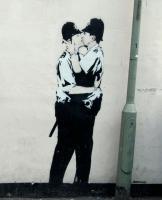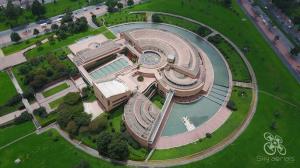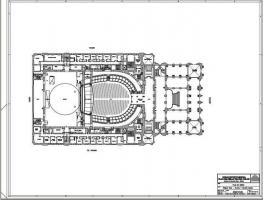11 fundamental works of Leonardo da Vinci
Leonardo da Vinci was a painter, sculptor, architect, and military engineer, but his name remained forever linked to painting. Therefore, here 11 of the most important works of the artist will be addressed in chronological order.
1. The annunciation
Painted between the years 1472 and 1475, The annunciation It is an oil painting on wood that represents Leonardo's first steps in painting, although not all agree with the verdict.
The painting was "hidden" in a monastery until 1867 when it was transferred to the Galleria degli Uffizi, in Florence. It was initially attributed to Domenico Ghirlandaio, a contemporary painter to Leonardo and also an apprentice in Verrocchio's workshop.
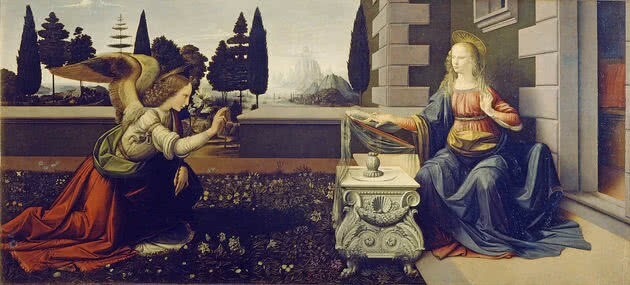
However, studies and analyzes after the work support the theory that this painting corresponds to one of Leonardo's early works. In reality, it will have been a joint effort, because when analyzing the painting it was perceived that the base and the Virgin would have been executed by Verrocchio.
Leonardo would have painted the angel, the flower carpet and the background landscape (the sea and the mountains). This is clear from the scientific precision with which the wings were painted, as well as the discovery of a preparatory drawing for the angel's sleeves attributed to Leonardo.
The difference between the delicacy of the angel and the almost cold majesty of the Virgin also seems obvious. In the same way, one can already see in the angel the use of the sfumato and chiaroscuro.
The scene represents the New Testament episode in which the angel visits the Virgin to tell her that she will give birth to the Messiah, son of God.
2. Portrait of Ginevra de 'Benci
The portrait of Ginevra de 'Benci was painted by Leonardo between 1474 and 1476. It is an oil on wood and is named after the person portrayed, who is a young aristocrat from Florence, famous and admired for her intelligence.
The young woman's head is framed by the leaves of a juniper bush, while in the background a careful natural landscape can be seen.

The young woman's expression is severe and haughty, and like most women of that time, Ginevra also shaved her eyebrows.
The size of the work was shortened, as it originally reached the young woman's waist and was to include the representation of her hands resting on her lap.
3. The Virgin of the Rocks
The Virgin of the Rocks It is an oil on wood and was executed around 1485. Here, the figures are in front of a grotto and their forms are shrouded in a mist (sfumato) which gives the painting an almost surreal character.
This composition is a perfect example of the mastery of chiaroscuro in Leonardo's painting, as well as the technique of sfumato that he developed.

The theme of the work is unique and enigmatic, as the child Saint John is represented adoring Jesus in the presence of the Virgin and an angel.
The meaning of this composition is not easy to interpret, but perhaps the secret lies in the use of the gesture (a characteristic detail of great importance for the artist).
Each figure is reproducing a different gesture, and here like other figures in other paintings, the angel points with his index finger, but in the direction of Saint John.
Meanwhile, the Virgin protects him, Saint John is in a position of adoration and the baby Jesus is blessing.
4. Vitruvian man
Around the year 1487 or 1490, Leonardo created the so-called Vitruvian man, an ink drawing on paper of two superimposed male figures with arms and legs separated within a circle and a square.
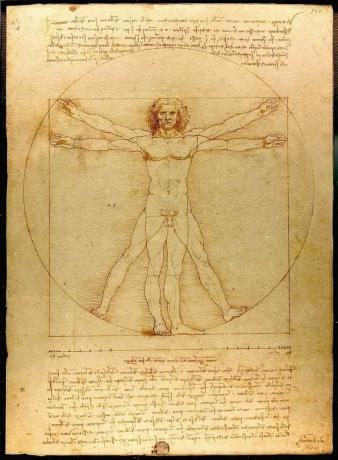
The drawing is accompanied by notes based on the work of the famous Roman architect Marco Vitruvius Polión. It is considered a study of proportions and a perfect juxtaposition between science and art, as well as one of the most significant works of the artist, scientist and inventor Leonardo da Vinci.
You may also like:
- The Vitruvian Man by Leonardo da Vinci.
- 15 characteristics of the Renaissance.
5. Lady with ermine
The Lady with ermine It is an oil painting on wood painted around the years 1489-1490 by Leonardo. The figure represented is Cecilia Gallerani, a supposed lover of the Duke of Milan, Lodovico Sforza, for whom Leonardo worked.

Due to the various interventions it has undergone over the centuries, the original background of the painting disappeared and was totally obscured, part of her dress was added as well as the hair that curls around Chin.
Analysis of the painting has revealed a door in the original background. In addition to that, it was also discovered that Leonardo could have changed his mind when painting the figure and that originally the position of the lady's arms would be different. Added to this is the fact that the ermine was added later.
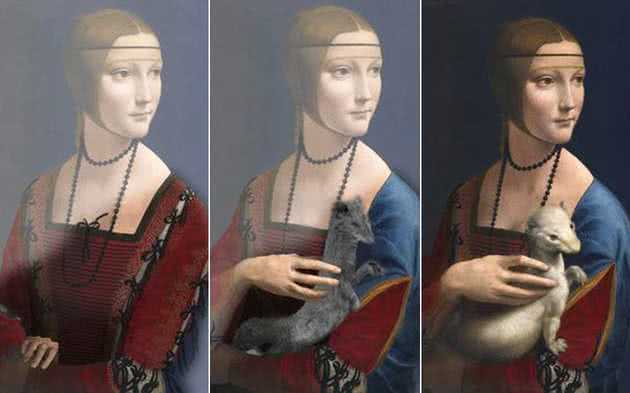
The survival of this painting until today is almost a miracle, since since 1800, when it was bought by a Polish prince, was repainted several times, suffered exile and went into hiding due to invasions and wars. In 1939, after the Nazi invasion, a footprint of an SS soldier was found in the painting.
6. La Belle Ferronière
Painted between 1490 and 1495, La Belle Ferronière it is also an oil on wood. The figure represented is an unknown woman, daughter or wife of a blacksmith.
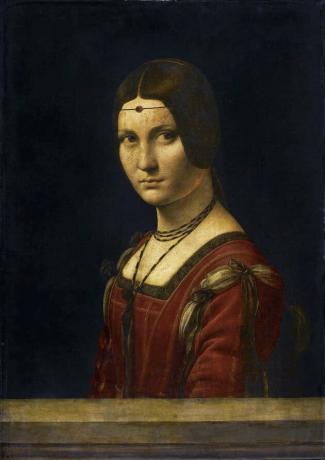
This painting is one of the four portraits made by the painter, a group that is completed with the Mona Lisa, Lady with ermine Y Givevra de 'Benci.
7. The Last Supper
The Last Supper It is a mural painting executed by Leonardo da Vinci between the years 1493 and 1498. It is found on the wall of the dining room of the Convent of Santa Maria Delle Grazie in Milan.
This is the work that will give the artist notoriety. But sadly, due to the fact that Leonardo applied an unorthodox technique that would compromise its durability. He thus mixed the techniques of tempera and oil on layers of plaster in a plaster.
Today it is necessary to make an effort to imagine all the splendor of that original painting, although it is still a miracle that it can still be contemplated.

As the title indicates, the painting represents the Last Supper between Jesus and the Apostles. The messiah is in the center of the composition and behind his head is a window that accentuates the effect of vanishing point of perspective.
Above the head of Jesus, a pediment acts as a halo. Thus, the importance of the architectural elements as support for the central figures of the composition is confirmed.
The moment captured will be just after Christ announces the betrayal of one of his disciples, which may be seen in the agitated gesticulation of the figures around the Messiah in contrast to their calm and serenity.
See also: Mural painting The Last Supper by Leonardo da Vinci
8. Salvator mundi
Salvator mundi It is an oil painting on canvas, possibly painted between the years 1490 and 1500, and was supposedly intended for King Louis XII of France and his consort Anne, the Duchess of Brittany.
During the years 1763 to 1900, the painting was missing and was believed to have been destroyed. Later it was discovered, restored and attributed to Leonardo. However, many scholars argue that such an attribution is wrong.

However, in November 2017, the work was auctioned and sold to an anonymous buyer as if it were Leonardo da Vinci. The auction reached a new record never imagined, and the work sold in 450,312,500 million dollars.
The composition represents Christ as the savior of the world, holding a crystal globe with his left hand and blessing with his right hand. Jesus appears dressed in typical Renaissance clothing.
9. The Mona Lisa
Also known as The Mona Lisa, The Mona Lisa It is an oil on wood painted by Leonardo between 1503 and 1506. The painting is a portrait of Mona Lisa, the young wife of Franceso de Giocondo, according to the testimony of Giorgio Vasari (1511-1574), painter, architect, and biographer of various Renaissance artists Italian.
The work was acquired by Francis I, King of France from 1515 to 1547. In 1911 the painting was stolen and recovered two years later, in 1913.
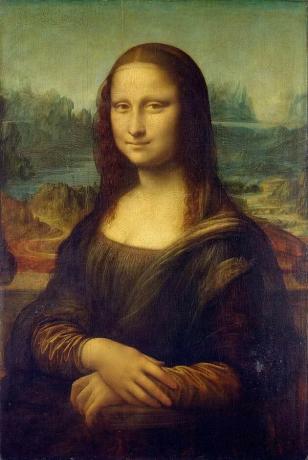
There are countless theories and speculations about this work, but its true wonder is not so much in the so-called enigmatic smile, but in the technique used.
The representation introduces the atmospheric perspective that will influence both the Baroque and Velázquez. In this portrait, Leonardo placed the figure in the foreground, painting it sharply, while the landscape is softly blurred.
This helps to build a feeling of distance from the landscape, but close to the female figure portrayed. Thus, the gaze is lost on the horizon. It is a perfect use of the techniques of the sfumato and the atmospheric perspective.
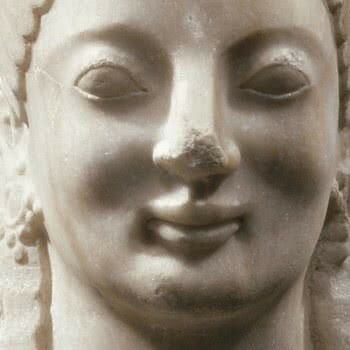
Regarding the portrait itself and his famous smile, it must be said that a similar expression is found in other works by the artist, such as Santa Ana and San Juan.
However, the smile may have only been the faithful representation of the model or expression of the influence of the archaic smile of Greek art (see image of Koré) that so influenced the Renaissance.
See detailed analysis of Mona Lisa painting
10. The Virgin and Child with Saint Anne
Painted in oil on wood, Madonna and Child with Saint Anne was executed in 1510. In it are represented three biblical figures: Santa Ana, mother of Mary, the Virgin and Jesus the Child. Jesus holds a lamb in his hand.
The figures are represented in a pyramidal shape against a rocky and poorly defined background. In this, part of the contours of Santa Ana are diluted in sfumato.
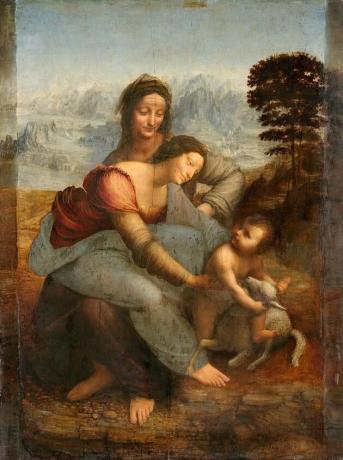
Despite being a fairly common iconographic theme, the strange thing is in the position of Maria, who is sitting on her mother's lap.
11. Saint John Baptist
Saint John Baptist It is an oil on wood made between 1513 and 1516. It is possible that it was the last work of the painter, already in the last years of the Renaissance and the beginning of Mannerism.
In this painting Saint John points upwards with the index finger of his right hand (a gesture repeated exhaustively in the artist's works), perhaps reinforcing the importance of the baptism in the Spirit for the salvation of the soul.
This representation of the figure of Saint John the Baptist differs from all previous archetypes, which until then represented the saint as a thin and fierce character.
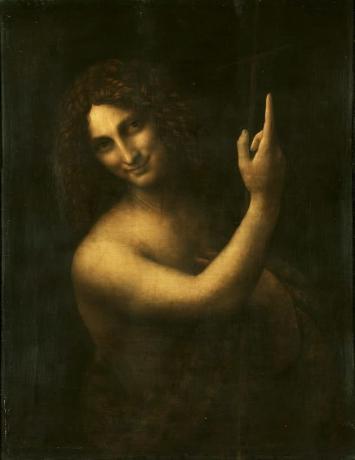
Saint John is represented here on an indecipherable background, and with more feminine than masculine lines. His posture, wrapped in sheep's wool, invokes sensuality, a seductive character, reminiscent of the satyrs of Greek mythology.
The play is haunting and disturbing. The androgynous character of Leonardo's painting is exposed once more in this work, as well as his mastery of the chiaroscuro technique. Besides that, the representation of Saint John the Baptist repeats the enigmatic smile of The Mona Lisa Y Saint Ana.
Interestingly, when Leonardo accepted Francis I's invitation to move to France in 1517, this painting was one of those that he decided to take with him, also adding the Mona Lisa Y The Virgin with the Child and Saint Anne.
It may interest you The 25 most representative paintings of the Renaissance
Biography of Leonardo da Vinci
Leonardo da Vinci (1452-1519) was born in a small town near Florence called Vinci. As he was the illegitimate son of a notary and a woman who probably would have been a slave, he was separated from his mother at age 5. When he was 14 years old, he entered Verrochio's workshop as an apprentice.
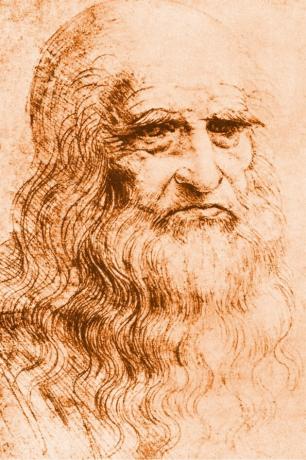
With no last name, he became known as Leonardo da Vinci. His full name would be Leonardo di ser Piero da Vinci, which means Leonardo son of (Mes) ser Piero de Vinci, since Leonardo's paternity is attributed to Messer Piero Fruosino de Antonio da Vinci.
Although he is remembered in history as a painter, only a little more than two dozen paintings attributed to him have survived to this time. Actually the explanation could be in the fact that Leonardo was never a very prolific painter.
Curious mind, he was interested in everything, but was not fully dedicated to anything. However, his contribution and influence on painting and art in general is undeniable.
For Leonardo, painting was the art par excellence, since the painter finishes his works with the effort of reason. Therefore, a painter is an intellectual, while the sculptor finishes his works with physical effort.
This and other ideas contributed to the disagreement that for years was nurtured between Leonardo and Miguel Ángel (for whom sculpture was the greatest art and who considered oil painting as something typical of the women).
Despite the fact that no portrait of the young Leonardo has reached us, the sculpture of David de Verrochio contains the features of Leonardo who, as a young man, had a rather attractive bearing.
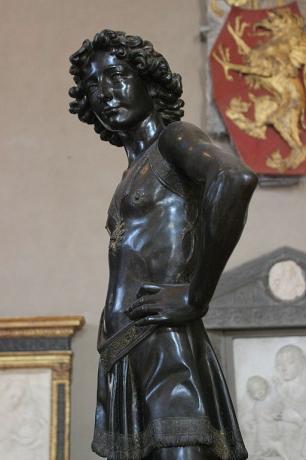
In 1476, still in Verrocchio's workshop, Leonardo was accused of sodomy, and was later acquitted of the accusation.
(Text translated by Andrea Imaginario).

